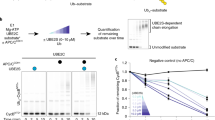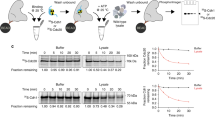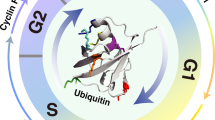Abstract
The anaphase-promoting complex (APC) is the crucial ubiquitin ligase targeting the regulatory machinery of the cell cycle. Emi1, a major modulator of APC activity, is thought to act competitively as a pseudosubstrate. We show that the modulation of APC activity is more subtle: Emi1 inhibits ubiquitylation at both substrate binding and separately at the step of ubiquitin transfer to APC-bound substrates. The zinc-binding region of Emi1 allows multiple monoubiquitylation of substrates, but preferentially suppresses the ubiquitin chain elongation by UBCH10. Furthermore, the carboxy-terminal tail of Emi1 antagonizes chain elongation by Ube2S, by competitively preventing its binding to the APC cullin subunit through electrostatic interaction. Combinatorially, Emi1 effectively stabilizes APC substrates by suppressing ubiquitin chain extension. Deubiquitylating enzymes can then convert inhibited substrates to their basal state. Chain elongation may be a particularly sensitive step for controlling degradation, and this study provides the first kinetic evidence for how it is inhibited.
This is a preview of subscription content, access via your institution
Access options
Subscribe to this journal
Receive 12 print issues and online access
$209.00 per year
only $17.42 per issue
Buy this article
- Purchase on Springer Link
- Instant access to full article PDF
Prices may be subject to local taxes which are calculated during checkout








Similar content being viewed by others
References
Peters, J. M. The anaphase promoting complex/cyclosome: a machine designed to destroy. Nat. Rev. Mol. Cell Biol. 7, 644–656 (2006).
Summers, M. K., Pan, B., Mukhyala, K. & Jackson, P. K. The unique N terminus of the UbcH10 E2 enzyme controls the threshold for APC activation and enhances checkpoint regulation of the APC. Mol. Cell 31, 544–556 (2008).
Wu, T. et al. UBE2S drives elongation of K11-linked ubiquitin chains by the anaphase-promoting complex. Proc. Natl Acad. Sci. USA 107, 1355–1360 (2010).
Song, L. & Rape, M. Substrate-specific regulation of ubiquitination by the anaphase-promoting complex. Cell Cycle 10, 52–56 (2011).
Rape, M., Reddy, S. K. & Kirschner, M. W. The processivity of multiubiquitination by the APC determines the order of substrate degradation. Cell 124, 89–103 (2006).
Lai, L. A., Morabito, L. & Holloway, S. L. A novel yeast mutant that is defective in regulation of the anaphase-promoting complex by the spindle damage checkpoint. Mol. Genet Genom. 270, 156–164 (2003).
Kramer, E. R., Scheuringer, N., Podtelejnikov, A. V., Mann, M. & Peters, J. M. Mitotic regulation of the APC activator proteins CDC20 and CDH1. Mol. Biol. Cell 11, 1555–1569 (2000).
Hsu, J. Y., Reimann, J. D., Sorensen, C. S., Lukas, J. & Jackson, P. K. E2F-dependent accumulation of hEmi1 regulates S phase entry by inhibiting APC(Cdh1). Nat. Cell Biol. 4, 358–366 (2002).
Reimann, J. D. et al. Emi1 is a mitotic regulator that interacts with Cdc20 and inhibits the anaphase promoting complex. Cell 105, 645–655 (2001).
Miller, J. J. et al. Emi1 stably binds and inhibits the anaphase-promoting complex/cyclosome as a pseudosubstrate inhibitor. Genes Dev. 20, 2410–2420 (2006).
Ohe, M. et al. Emi2 inhibition of the anaphase-promoting complex/cyclosome absolutely requires Emi2 binding via the C-terminal RL tail. Mol. Biol. Cell 21, 905–913 (2010).
Meyer, H. J. & Rape, M. Processive ubiquitin chain formation by the anaphase-promoting complex. Semin. Cell Dev. Biol. 22, 544–550 (2011).
Tang, W. et al. Emi2-mediated inhibition of E2-substrate ubiquitin transfer by the anaphase-promoting complex/cyclosome through a D-box-independent mechanism. Mol. Biol. Cell 21, 2589–2597 (2010).
Saha, A. & Deshaies, R. J. Multimodal activation of the ubiquitin ligase SCF by Nedd8 conjugation. Mol. Cell 32, 21–31 (2008).
Wickliffe, K. E., Lorenz, S., Wemmer, D. E., Kuriyan, J. & Rape, M. The mechanism of linkage-specific ubiquitin chain elongation by a single-subunit E2. Cell 144, 769–781 (2011).
Kleiger, G., Saha, A., Lewis, S., Kuhlman, B. & Deshaies, R. J. Rapid E2–E3 assembly and disassembly enable processive ubiquitylation of cullin-RING ubiquitin ligase substrates. Cell 139, 957–968 (2009).
Da Fonseca, P. C. et al. Structures of APC/C(Cdh1) with substrates identify Cdh1 and Apc10 as the D-box co-receptor. Nature 470, 274–278 (2011).
Choi, E., Dial, J. M., Jeong, D. E. & Hall, M. C. Unique D box and KEN box sequences limit ubiquitination of Acm1 and promote pseudosubstrate inhibition of the anaphase-promoting complex. J. Biol. Chem. 283, 23701–23710 (2008).
Herzog, F. et al. Structure of the anaphase-promoting complex/cyclosome interacting with a mitotic checkpoint complex. Science 323, 1477–1481 (2009).
Schaefer, J. B. & Morgan, D. O. Protein-linked ubiquitin chain structurerestricts activity of deubiquitinating enzymes. J. Biol. Chem. 286, 45186–45196 (2011).
Gibson, D. G. et al. Enzymatic assembly of DNA molecules up to several hundred kilobases. Nat. Methods 6, 343–345 (2009).
Kraft, C., Gmachl, M. & Peters, J. M. Methods to measure ubiquitin-dependent proteolysis mediated by the anaphase-promoting complex. Methods 38, 39–51 (2006).
Rape, M. & Kirschner, M. W. Autonomous regulation of the anaphase-promoting complex couples mitosis to S-phase entry. Nature 432, 588–595 (2004).
Fang, G., Yu, H. & Kirschner, M. W. The checkpoint protein MAD2 and the mitotic regulator CDC20 form a ternary complex with the anaphase-promoting complex to control anaphase initiation. Genes Dev. 12, 1871–1883 (1998).
Carroll, C. W. & Morgan, D. O. Enzymology of the anaphase-promoting complex. Methods Enzymol. 398, 219–230 (2005).
Acknowledgements
We wish to thank the members of the Kirschner Laboratory for advice, especially T. Wu and Y. Lu for discussions and insightful suggestions. The work was supported by a grant from the National Institute of General Medical Sciences, R01 GM039023.
Author information
Authors and Affiliations
Contributions
W.W. and M.W.K planned the project. W.W. designed, carried out and analysed all experiments. W.W. and M.W.K. interpreted the data. The manuscript was written by W.W. and M.W.K.
Corresponding author
Ethics declarations
Competing interests
The authors declare no competing financial interests.
Supplementary information
Supplementary Information
Supplementary Information (PDF 4582 kb)
Rights and permissions
About this article
Cite this article
Wang, W., Kirschner, M. Emi1 preferentially inhibits ubiquitin chain elongation by the anaphase-promoting complex. Nat Cell Biol 15, 797–806 (2013). https://doi.org/10.1038/ncb2755
Received:
Accepted:
Published:
Issue Date:
DOI: https://doi.org/10.1038/ncb2755
This article is cited by
-
EMI1 switches from being a substrate to an inhibitor of APC/CCDH1 to start the cell cycle
Nature (2018)
-
Insights into APC/C: from cellular function to diseases and therapeutics
Cell Division (2016)
-
Structural insights into the catalysis and regulation of E3 ubiquitin ligases
Nature Reviews Molecular Cell Biology (2016)
-
Atomic structure of the APC/C and its mechanism of protein ubiquitination
Nature (2015)
-
Spatiotemporal regulation of the anaphase-promoting complex in mitosis
Nature Reviews Molecular Cell Biology (2015)



